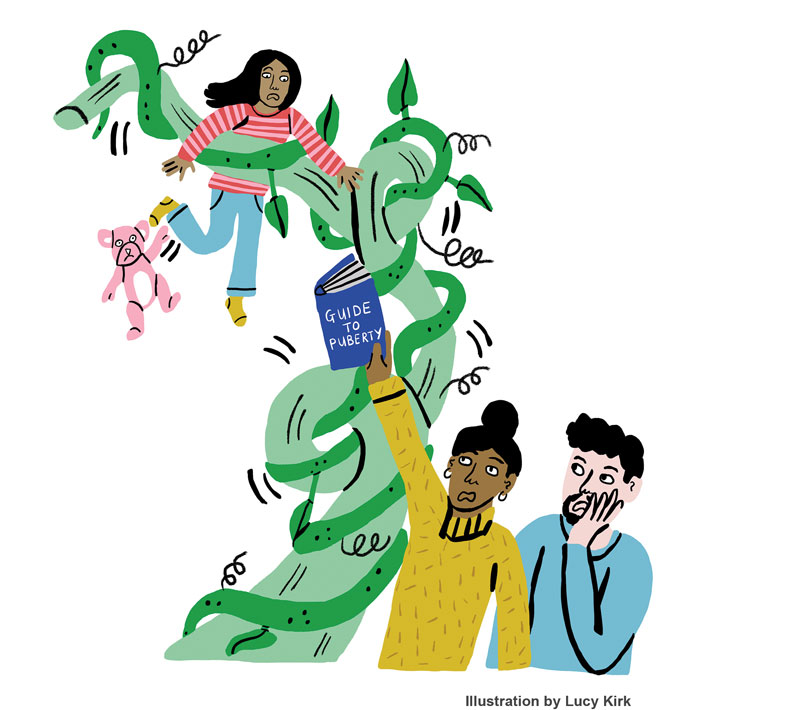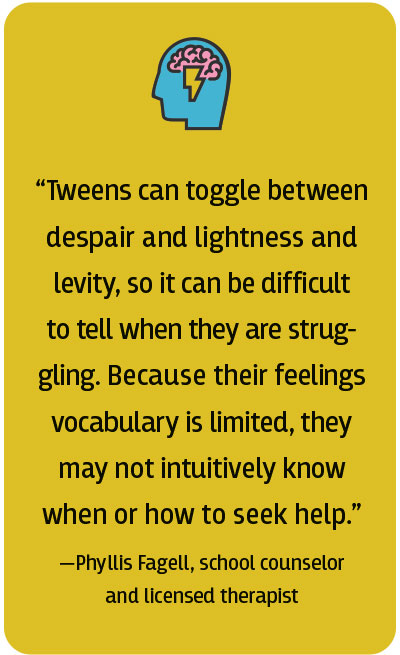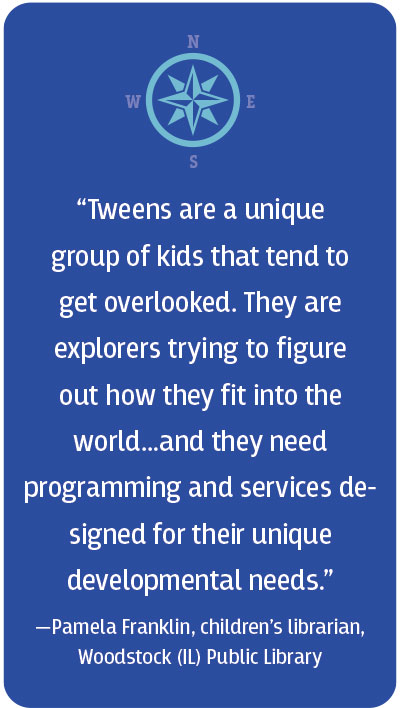Quarantweens: Helping Kids Survive Adolescence at Home
The pandemic presents unique challenges for the nearly 23 million nine- to twelve-year-olds in the United States. Here are ways to support them.

Unique. Overlooked. Emotionally intense. Under pressure. These are just a few words and phrases that can describe some of the nearly 23 million nine- to twelve-year-olds in the United States.
These tweens are immersed in a crucial and challenging developmental stage, craving independence and identity as they try to maneuver the tightrope connecting childhood to full-blown adolescence.
And for many of these kids, the COVID-19 pandemic has complicated that delicate and essential process. It has also raised questions about the impact of pandemic-related school closures, loneliness, and poverty on tweens—and their busy brains and bodies.
All kinds of change
“I have been saying for a while that [in terms of its impact on children], the pandemic is hitting tweens the hardest,” says school counselor and licensed therapist Phyllis Fagell.
Fagell, who is the author of Middle School Matters: The 10 Key Skills Kids Need to Thrive in Middle School and Beyond—and How Parents Can Help (Da Capo, 2019), says that this is in part because of the significant change tweens undergo normally.
“Kids change faster in the tween years than at any other point in their lives, aside from birth to age two, and they are changing socially, emotionally, cognitively, physically, morally,” she says.
Socially, tweens are exploring issues of self and identity—trying to understand who they are. According to Fagell, this process includes spending more time with peers, at a time when friendships are quite fragile. “Only two-thirds of tween friendships make it from fall to spring of sixth grade,” she says.
Along with establishing identity and navigating social pressure to “fit in” (studies show that being excluded from social circles rates among tweens’ biggest fears), tweens are dealing with cognitive and emotional changes.
Maryam Jernigan-Noesi, clinical psychologist and coauthor of the children’s book I Miss My Friend, points to substantial neurological and physical development across the gender continuum, including puberty, menstruation (which can start as early as age eight), growth spurts, hormone shifts, and mood fluctuations.
“Tweens may feel one emotion and in the next moment shift their disposition,” she says. “For example, a sweet and engaged tween can quickly swing to a more difficult mood, which can be confusing.”
According to the Mayo Clinic, mood swings are generally a normal part of tween development. The brain is not fully developed until the mid-20s, and tween decision-making is primarily driven by the amygdala—which is involved with the experiencing of emotions, rather than the prefrontal cortex, the large, more rational “control center” of the brain.
Notably, the neurological changes also impact cognitive skills. For instance, because the prefrontal cortex is not fully developed, tweens can struggle with organization, planning, and prioritizing.
These skills are always important, but perhaps more so amid the pandemic, because so many students are separated from school and the structure, resources, and in-person connections they need most.
 Plus, the pandemic
Plus, the pandemic
“Children are losing social, problem-solving, and communication skills [because of pandemic-related isolation],” says Lauren Davis, a middle-level researcher and assistant professor of curriculum and instruction at Montana State University.
“That isolation can heighten emotional challenges for adolescents including anxiety and depression, for which tweens are at high risk,” she says. However, the nature of tween emotions can make it hard to recognize when they are in crisis.
“Tweens can toggle between despair and lightness and levity, so it can be difficult to tell when they are struggling,” Fagell says. “Because their feelings vocabulary is limited, they may not intuitively know when or how to seek help.”
“Tweens are extra sensitive, and the absence of in-person social interactions can leave them even more susceptible to rumination, for example, whether they get dropped from a text chain or left out of plans to make a TikTok video,” she explains.
In these unprecedented times, tweens’ need for privacy and independence can also clash with the realities of pandemic restrictions. “Some tweens are literally home with parents 24-7,” notes Fagell.
Meanwhile, other tweens have parents who cannot work from home. This can be complicated, because, as Fagell explains, tweens want to connect with their parents—just in nonintrusive ways. “A child can miss a parent who is at work all day, but bristle if that same parent asks too many questions when they come home,” she says.
Jealousy can also muddy the water. For example, “one kid might be envious of a friend whose parents aren’t home all day and hovering over them, while another is jealous of a friend whose parents can work from home,” Fagell notes.
In addition to tweens’ age-appropriate emotional, social, and cognitive challenges, Jernigan-Noesi says that she and her fellow psychologists are “seeing more children affected by abuse and less than ideal living circumstances.”
Columbia University reports that nearly eight million more Americans have been living below the poverty line since the start of the pandemic, while Food America estimates that nearly double that number have become food insecure. In effect, 18 million (or nearly one in four) children in the United States may currently reside in households where there is not enough to eat.
That, along with supply shortages due to the pandemic, is also exacerbating lack of access to products for menstruation (i.e., “period poverty”). A nationwide study, “State of the Period,” found that 20 percent of U.S. teen girls struggle to afford feminine hygiene products, or cannot afford them at all.
Pre-pandemic, one in five girls reportedly missed school during their period because of this. Now, with many schools closed, access to free pads and tampons (in the restroom or school nurse’s office) has diminished. This loss can go undetected and cause hardships for tween girls who may be experiencing their first periods.
As a result, Jernigan-Noesi says, “It is important to check in to establish how a tween may be adjusting and to potentially identify significant mental, and physical health concerns.” This might mean connecting parents and families with trusted professionals like school counselors, social workers, and psychologists.
On the academic front, “tweens may also need more assistance because this is a time when content difficulty and class and homework loads increase,” Jernigan-Noesi says. In addition, Fagell points out that “tweens lack executive functioning skills that help them anticipate how today’s work ethic impacts tomorrow’s product.”
“Those skills don’t kick in until around age 15 or so,” she explains. “Meanwhile, distance learning and hybrid programs demand a lot of organization from students who struggle with those skills in normal times.”
 A librarian’s support strategy
A librarian’s support strategy
Even in so-called normal times, “tweens are a unique group of kids that tend to get overlooked,” says Pamela Franklin, children’s librarian at Woodstock (IL) Public Library. “They are explorers trying to figure out how they fit into the world…and they need programming and services designed for their unique developmental needs.”
For Franklin, this means STEAM-based programs, and programming that celebrates fandoms or helps tweens find their identity: tween advisory boards, community volunteer opportunities, or a room-decorating program to help tweens find a more grown-up look for their spaces.
“If tweens love something, they are obsessed with it, and the library can create a space for them to connect with other tweens with similar interests,” she says.
Before the pandemic, Franklin oversaw successful STEAM book clubs based on the popular “Percy Jackson” and “Wings of Fire” series. For her more passive Secret Book Club offerings, tweens selected wrapped books on tween topics and concerns.
However, COVID-19 has dramatically changed library services and programming. “Now more than ever, we have to reach out actively to build and maintain connections with our communities,” says Franklin. “I have also been forced to reduce and redesign tween programming and services.”
Through trial and error, Franklin has had success with ready-to-go craft kits (for example, hot-chocolate bomb kits) and online escape rooms and trivia that can be done at leisure with friends and family. Secret Book Club offerings are available for curbside pickup, and she is working on themed (e.g., “Harry Potter,” “The Baby-Sitters Club”) take-home subscription boxes for tweens.
Franklin believes that successful engagement with tweens always hinges on collaboration. “Work with coworkers, schools, and other organizations in your community…to cast your net wide and reach more tweens,” she says.
“Also, by building one-on-one connections with tweens,” she says, “the library can offer support and empowerment, help tweens use their time constructively, and create a commitment to learning,” she says.
Future flexibility
To encourage engagement in these difficult times, Davis advocates virtual “show and tell” at the start of classes. (“Even my college students like to show off their pets,” she says.) Fagell suggests starting with an open-ended inquiry: “Ask them something about themselves and how you can best support them.” For tweens who are stuck at home, Fagell notes that apps can be helpful. “Daylio lets you track your mood and what you were doing at the time so you can draw some connections. Worry Float is a way to write down and release your worries. Mood Meter expands kids’ feelings vocabulary. Apps like Calm and Stop Breathe Think can also give kids some great mindfulness strategies,” she says. Overall, Fagell feels that kids are resilient but need the presence of a loving and caring adult—if not a parent, then a relative, guardian, or other grown-up—who can help shore up their resiliency in these challenging times. “I hope kids can use the skills they are acquiring now—gratitude, flexibility, ability to sit with discomfort—the next time they hit a rough patch.... They may not retain as much academic content as in the past, but they are forging important life skills.”
Support and empowerment are also priorities for Jernigan-Noesi. “We need to create spaces for tweens to talk and process their experiences,” she says. This can include discussing the COVID-19 pandemic, correcting misinformation, and engaging tweens in family decisions. She also advocates “being flexible when circumstances demand it.”
“It is time to reframe and perhaps lessen the pressure we may place on tweens and other youth to ‘catch up, be normal, or return to normal,’” she says.
Kelley R. Taylor is a writer, journalist, and legal counsel who strives to help inform and empower people on issues that impact their daily lives and work.
RELATED
The job outlook in 2030: Librarians will be in demand
The job outlook in 2030: Librarians will be in demand
ALREADY A SUBSCRIBER? LOG IN
We are currently offering this content for free. Sign up now to activate your personal profile, where you can save articles for future viewing






Add Comment :-
Be the first reader to comment.
Comment Policy:
Comment should not be empty !!!